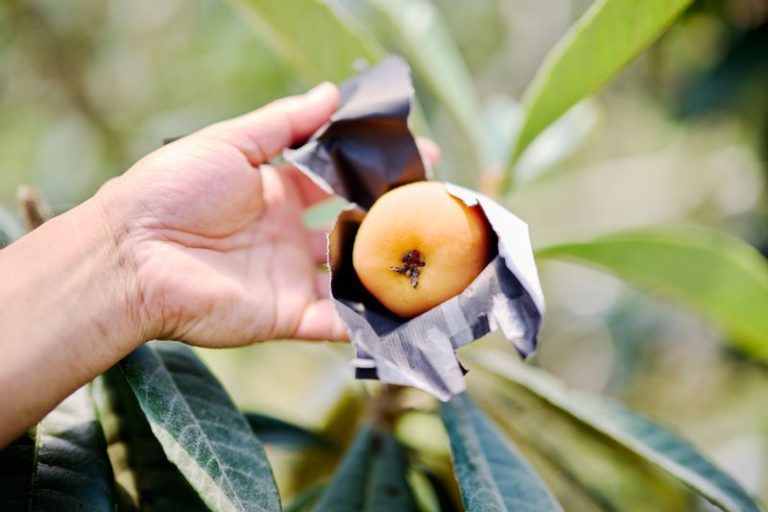Boshu Biwa, a Juicy, Early Summer Fruit Grown in Minami-Boso

An early summer gift to the imperial family since Japan's Meiji era

The loquat, a fruit with a pale orange rind and a pleasing rounded shape, belongs to the rose family. According to records, the cultivation of Boshu Biwa began in Chiba Prefecture in 1751. It was then transported and sold in the markets of Edo (Tokyo’s previous name) during the mid-Edo period (1603-1867) under the same name. It has been cultivated more intensively since the Meiji period (1868-1912), and every year since 1909, the Boshu Biwa selected by a judging committee has been offered to the Imperial Household.

Loquats are sensitive to cold and typically grow in warmer areas like Minami Boso, Tateyama, and Kyonan, near the southern tip of the Boso Peninsula. Loquat production in Chiba Prefecture is second only to that of Nagasaki Prefecture. Its exceptional quality has made it a highly sought-after delicacy during early summer, often resulting in loquats being sold out each year.
Cold weather is a mortal enemy to the delicate Boshu Biwa, as it requires time and care to cultivate.

Driving inland from the coast, we headed to Kaju Kano in the Numa district of Tateyama. The loquat trees lining the greenhouses were full of fruit, bagged and waiting to be picked.

The orchard owner, Satoshi Togano, aims to produce beautiful and tasty loquat for gift-giving. He currently grows two varieties: Tomifusa, an early-ripening variety, and Mizuho, known for its large fruit. Greenhouse-grown loquats are harvested in May, and roadside loquats in June.
The most sensitive period for loquat cultivation is winter when loquats flower and fruit from December to January. If the temperature falls below -3 degrees Celsius, the fruit stones will freeze and rot. Therefore, heaters are turned on, and temperatures are thoroughly controlled during winter, even in greenhouse cultivation.

The skin of loquats is soft and easily damaged. Each fruit is individually bagged from late February to protect it from pests and leaf rubbing. When the skin’s orange color becomes darker and the bottom part, called the “navel,” turns black and dry, it is time to harvest. The fruits are handled with the utmost care during shipping and transportation to avoid damage.

Satoshi explains with a laugh: “A good loquat should be dark orange, rounded without being angular, and covered with a thick fuzz of hair. Friction causes the hairs to fall out and the fruit to become shiny, so I touch the fruit as little as possible. Although the fruit is delicate, I have to admit that it is not too much work for me, and I enjoy it all very much. I’m constantly researching to produce the ideal loquat.”

When I peeled Satoshi’s loquat, I found lush pulp under the thin skin. When eaten, more juice overflowed, filling the mouth with a refreshing and exquisite sweetness similar to that of peaches and pears.
Reviving an orchard ravaged by a typhoon from the ground up. A young farmer's challenge.
Satoshi relocated to Tateyama from Tokyo four years ago. Following a year of agricultural training, he began farming and is now harvesting Boshu Biwa at his orchard in his third season. He started growing loquat after a major typhoon hit the Boso Peninsula in September 2019.

“Due to the typhoon, the loquat orchard was damaged, and we couldn’t grow them for some time. The original owner was elderly, so I decided to take over. The first thing I did to revive the damaged trees was to stop using herbicides, let the weeds grow, and irrigate the soil to improve it. I had no knowledge at all, but with the help of the farmers around me, I was finally able to produce good loquat crops this year. We still have a long way to go, both in loquat production and in the restoration of the farm,” says Satoshi.
Satoshi had worked in the food service industry for 15 years. He hopes to utilize his experience and network in agriculture and food service to promote Boshu Biwa in the future.

He explains, “Boshu Biwa is an appealing fruit to eat as it is, but also as an ingredient. Currently, we are working with a pastry store to make confiture. But I also want to collaborate with chefs, as it pairs well with blue cheese and burrata. Along with pursuing high-quality loquat production, I want to work with restaurants to promote the deliciousness of Boshu Biwa.”
The lush Boshu Biwa is a delectable early-summer fruit. We would like everyone to savor it in a variety of ways.






